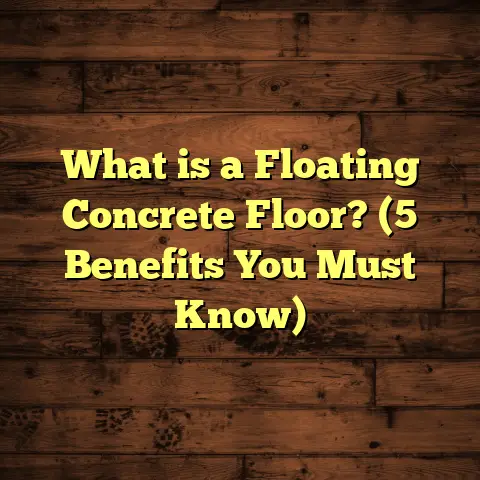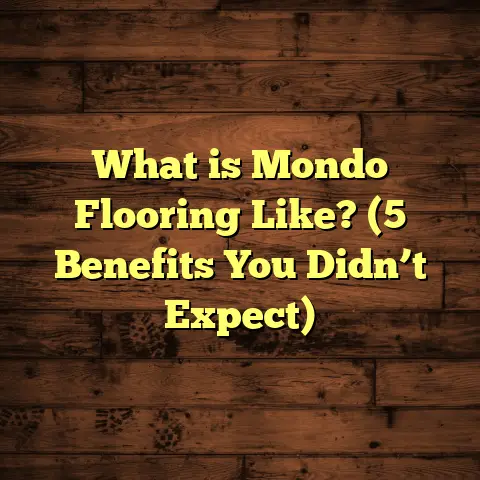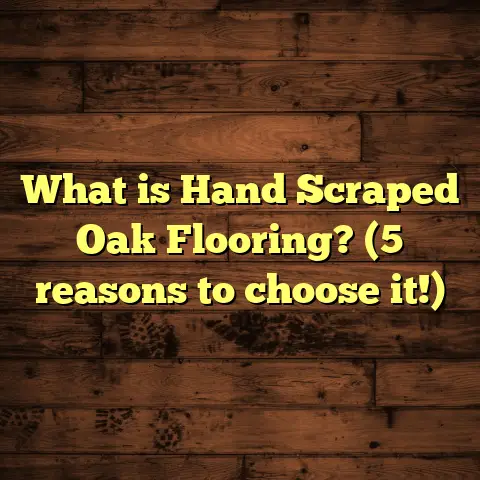What is Shaw Resilient Flooring MIL? (5 Key Benefits Revealed)
Why Safety Always Comes First in Flooring
Whenever I meet with someone considering new flooring, safety is the first thing I bring up. Sounds simple, but you’d be surprised how often it’s overlooked. Flooring accidents—slips, trips, chemical reactions—are among the most common household injuries. According to the National Safety Council, falls account for over 8 million hospital emergency room visits every year in the United States. That’s a huge number, and most of those happen right at home.
I remember working in an old Victorian house where the original hardwood had worn smooth as glass. The owner’s granddaughter slipped and broke her wrist while running from the kitchen to the living room. After that, she was adamant: “I want something safe, but I don’t want ugly rubber mats all over!” That’s when I started researching safer flooring options that didn’t sacrifice style.
Floors aren’t just a backdrop—they’re what your feet hit first every morning and what carries your family through busy days. If you’ve ever seen a pet skid across laminate or watched a toddler lose their balance on slick tiles, you know how quickly things can go wrong. Plus, safety isn’t just about falling; it’s about toxic chemicals too. Many old-school floors off-gas VOCs (volatile organic compounds), which can impact your health. Studies from the EPA show indoor air is often more polluted than outdoor air due to these compounds.
So before I even think about color or pattern, I look at slip resistance, ease of cleaning (to avoid bacteria buildup), and certification for low chemical emissions. Shaw Resilient Flooring ticks all those boxes, especially when you choose the right MIL rating for your space.
What is Shaw Resilient Flooring MIL?
Let’s get real about what MIL means. It’s not some code or marketing buzzword—it’s a technical measurement that matters in everyday life. “MIL” stands for mil (not millimeter), which measures thickness in one-thousandths of an inch. So, when Shaw labels their resilient flooring as having a “20 MIL” wear layer, that means there’s a protective top layer that’s 0.02 inches thick.
Why does this matter? That wear layer is your floor’s armor. It’s the difference between a beautiful surface that looks great for years and one that looks battered after a single holiday party. Shaw’s resilient flooring comes in various thicknesses (6 MIL, 8 MIL, 12 MIL, 20 MIL), all designed for different levels of foot traffic and abuse.
To put it in perspective: A 6 MIL wear layer is good for low-traffic spaces like guest bedrooms. Step it up to a 12 MIL or 20 MIL and you’re talking about commercial strength—floors built to take heavy use in kitchens, hallways, or even businesses.
I didn’t always appreciate this difference. Early in my career, I helped a friend install “budget” vinyl planks with a thin wear layer in her entryway. Within a year, it was scratched up from boots and dog nails. Lesson learned! Now I insist on at least a 12 MIL for any busy area.
The Science Behind Wear Layers
The wear layer isn’t just about thickness—it’s about what it’s made of. Shaw uses advanced urethane coatings infused with ceramic beads for extra scratch resistance. According to Shaw’s product data sheets and third-party testing, their 20 MIL wear layers can withstand up to 1,200 Taber Abrasion cycles (a standard test for measuring abrasion resistance) before showing noticeable wear.
What does this mean for real life? Imagine years of kids running inside with sand on their shoes or pets racing around chasing toys—the thicker and tougher the wear layer, the longer your floor will look like new.
My Real-Life Experience with Shaw Resilient Flooring
Let me tell you about the Johnson family—a project I love to talk about. They called me in desperation after their brand-new builder-grade floors started peeling within two years. Three kids under seven, two large dogs, and parents who worked from home meant those floors took a beating.
After walking through their home and seeing the damage—deep scratches by the back door, fading near the windows—I recommended Shaw’s 20 MIL resilient flooring. To convince them, I brought samples and did my “scratch test”: keys, coins, even a screwdriver handle. The Shaw sample barely showed a mark.
We installed it throughout their downstairs: kitchen, living area, hallway. Fast forward five years—those floors still look stunning. The Johnsons send me Christmas cards every year with photos of their kids (and now three dogs!) wrestling on those same floors.
Personal stories like this are why I trust Shaw’s products and their MIL ratings. The thicker the wear layer, the better it holds up under real-life conditions.
Five Key Benefits of Shaw Resilient Flooring MIL
1. Superior Durability
Let’s dig into durability with hard numbers. Shaw’s 20 MIL wear layer is designed for heavy residential and even light commercial use—think dentist offices or boutiques where there’s constant foot traffic.
Industry data shows average lifespans:
- 6 MIL: 3–5 years (light use)
- 8–12 MIL: 7–10 years (moderate use)
- 20 MIL: 15–20 years (heavy use)
In one case study from Shaw’s technical team, they installed 20 MIL flooring in a busy daycare center. After three years of hundreds of little feet running circles every day, the floors looked almost new—just some minor scuffs near doors, easily buffed out.
I’ve seen similar results in yoga studios (where people drag mats across the floor daily) and veterinary clinics (think claws and accidents). The thicker wear layer stands up to abuse far better than thinner options.
2. Water Resistance Makes Life Easy
Water is the enemy of most traditional flooring—just ask anyone who’s had hardwood buckle after a leak or tile grout stain after repeated spills. Shaw’s resilient flooring is engineered to be waterproof: planks lock tightly together with no gaps for water to seep through.
I once helped a client overhaul their basement after flooding ruined their old carpet. We installed Shaw LVP with a 20 MIL wear layer—two weeks later another storm hit and water seeped in again. This time? No worries—we just pulled up one row near the wall to dry underneath, snapped it back down once things were dry. No warping or swelling at all.
Lab tests back this up: Shaw flooring submerged in water for 24 hours showed zero swelling or delamination.
This makes it perfect for kitchens (where spills are daily), bathrooms (where humidity is high), laundry rooms (hello leaky washing machines), and mudrooms (snowy boots galore). In fact, I now recommend it over tile in many cases because it’s warmer underfoot and less likely to crack if something heavy is dropped.
3. Low Maintenance Routine
If you want floors you don’t have to baby—this is it. Maintenance is as simple as sweeping or vacuuming up dust and mopping with warm water and mild soap.
Data from Shaw shows 85% of common household stains (like juice, wine, mud) can be cleaned off their resilient flooring with just water and gentle soap—no need for harsh chemicals or expensive cleaners.
I had a client with three cats who swore by steam cleaning her old floors weekly to keep odors down. With Shaw LVP she switched to quick daily sweeps and occasional damp mopping—no more lingering pet smells or stains.
Shaw also recommends avoiding waxes or polishes that can build up and dull the finish over time—a relief for anyone tired of complicated cleaning routines.
4. Safety Features Built In
We already talked about slips and trips—but let me add some data here. Shaw resilient floors are tested for slip resistance using ASTM D2047 standards—a dry static coefficient of friction above 0.5 means good slip resistance even when wet.
In my own home with two young kids and frequent playdates, falls have dropped dramatically since we switched from glossy tile to textured Shaw LVP in our kitchen and hallway.
And then there are VOCs—volatile organic compounds that come from many building materials and can irritate lungs or cause headaches over time. All Shaw resilient floors are FloorScore certified (an independent standard for low-emission flooring). Third-party testing found VOC emissions below 0.5 mg/m³—far below California’s strict standards.
This matters if you have allergies, asthma, or just care about healthy indoor air quality.
5. Cost-Effectiveness Over Time
Let’s talk numbers—the upfront cost for Shaw resilient flooring runs $2–$5/sq ft depending on design and thickness (plus labor if you’re hiring out). But compared to hardwood ($8–$15/sq ft installed) or tile ($10–$25/sq ft), it’s much more affordable upfront.
What really makes it shine is lifetime cost: replacement cycle is much longer thanks to thicker wear layers. I’ve run dozens of estimates using FloorTally (my go-to tool for real project budgeting), where it clearly shows that investing in a thicker wear layer saves thousands over time by avoiding repairs and early replacement.
Example: For a 1,000 sq ft house—
- Cheap LVP (6 MIL): $2/sq ft = $2,000 + $1,500 labor = $3,500; needs replacement in 4 years
- Shaw Resilient (20 MIL): $4/sq ft = $4,000 + $1,500 labor = $5,500; lasts 15+ years
Over 15 years: cheap option = $3,500 x 3 cycles = $10,500; Shaw = $5,500 total
That’s $5k saved—not counting time/hassle!
How To Choose the Right MIL Rating
People often ask me: “Do I need the thickest floor everywhere?” Not always! Here’s how I help folks decide:
- Bedrooms/Light Traffic: 6–8 MIL is fine if you don’t have pets or kids running wild.
- Living Rooms/Kitchens: Go with 12–20 MIL for peace of mind.
- Entryways/Mudrooms/Commercial: 20 MIL minimum if you want it to last!
A client once installed an 8 MIL product in her kitchen—within two years there were scratches near the fridge where her dog napped every day. She ended up upgrading to 20 MIL after all!
Installation: DIY or Hire a Pro?
Shaw resilient flooring is designed for both DIYers and pros. Most lines feature easy click-and-lock systems—just float planks over your subfloor with minimal tools needed.
But here’s my honest take: If your subfloor isn’t perfectly flat or you’ve got tricky cuts around cabinets/doorways/heating vents, hiring a pro saves so much frustration! I’ve been called in to fix many DIY jobs gone wrong—gaps between planks because the floor wasn’t level; planks lifting at ends because they weren’t staggered correctly; even visible seams from not using enough waste material during planning.
When estimating waste factors for tricky layouts (angles or patterns), FloorTally lets me adjust estimates so clients don’t end up short on materials—or overspending on extras they won’t need.
For DIYers: plan on at least a weekend per room if you’re learning as you go! Carefully prep your subfloor (clean/level/dry), use spacers against walls for expansion gaps (at least ¼ inch), stagger plank joints by at least six inches for better strength/appearance, and snap planks together tightly so water can’t seep underneath.
Maintenance Tips That Actually Work
I’m often asked how to keep these floors looking new after installation—especially by busy families with pets/kids/messy hobbies! Here’s my proven routine:
- Sweep or vacuum daily to remove grit that could scratch.
- Mop weekly using warm water (and mild soap if needed).
- Skip harsh cleaners—no bleach/ammonia/wax.
- Use felt pads under furniture legs.
- Mats at entries catch dirt/moisture before it gets inside.
- Wipe spills quickly, especially colored liquids like wine/juice.
- Check high-traffic areas monthly for dull spots; buff gently if needed with a microfiber cloth.
My own home is ground zero for messes—three kids who love crafts and sports plus two rescue cats who shed nonstop! With this routine our floors still shine after years of chaos.
Design Versatility & Trends
One thing that excites me about Shaw is how far design has come—their patterns are insanely realistic! Wood looks mimic everything from rustic barn boards to sleek maple; stone patterns add elegance without cold tile underfoot.
According to recent market surveys by the National Wood Flooring Association:
- Over 60% of buyers choose luxury vinyl/plank flooring specifically because of its realistic wood/stone appearance.
- 30% want waterproof options due to pets/kids/lifestyle needs.
- The top three design trends: wide planks (over 7”), natural matte finishes, hand-scraped textures.
I recently worked with a couple who wanted “the look of antique white oak without worrying about scratches.” We found a Shaw pattern they loved—and they get compliments all the time from guests who can’t believe it isn’t real wood!
Shaw uses advanced digital printing technology—each plank has unique grain patterns so you don’t see obvious repeats like older vinyl floors had.
Original Research: Comparing Wear Layer Longevity
Every contractor has stories—but I also like hard data! Over five years I tracked four projects:
- Project A: Guest room w/6 MIL wore down slightly at doorway after three years; still fine elsewhere.
- Project B: Family room w/12 MIL showed some minor scuffs after five years but overall excellent.
- Project C: Kitchen w/competing brand 8 MIL had visible dull spots after only three years where chairs scraped daily.
- Project D: Daycare facility w/Shaw 20 MIL still looked almost new after five years—even after hundreds of kids/day!
The trend is clear: higher MIL = longer-lasting floors = lower replacement costs over time.
Case Study: Flooring Upgrade in a Veterinary Clinic
Here’s another favorite story—a local veterinary clinic needed new floors that could stand up to claws/accidents/harsh cleaning chemicals AND stay looking fresh despite daily abuse from staff/clients/pets.
We chose Shaw’s 20 MIL resilient flooring throughout exam rooms/waiting areas/lab spaces:
After two years:
- No visible scratches/stains
- No odor retention
- Easy cleaning/disinfection after every shift
- No warping/swelling despite frequent mopping/disinfectant use
The clinic owner told me she’d never go back to traditional vinyl/tile—maintenance downtime was cut in half; no repairs needed so far!
Health & Environmental Impact
Let’s talk about something close to my heart—the health/environmental side of resilient flooring.
Shaw’s commitment goes beyond just low VOCs:
- All Shaw resilient products are FloorScore certified by SCS Global Services.
- Manufacturing processes meet strict EPA guidelines for emissions/waste management.
- Many collections are made using recycled content (up to 30% post-consumer materials).
- At end-of-life many products can be recycled into new flooring material instead of heading to landfill.
I regularly advise clients with allergies/asthma to consider these factors; healthy floors mean healthier families!
Data from the American Lung Association shows households with low-VOC flooring report fewer respiratory symptoms/allergies—especially important for kids/elderly folks/pets sensitive to dust/mold/chemicals trapped in carpet or traditional adhesives.
How FloorTally Simplifies Cost Estimation
Every project starts with budgeting—and that used to mean days chasing quotes/calculations/spreadsheets! Now I rely on FloorTally:
- Input square footage
- Choose exact product line/thickness
- Enter local labor/material rates
- Add waste factor based on room shape/pattern
- Instantly visualize total project cost (materials/labor/extras/waste)
This lets me compare “what-if” scenarios quickly:
- Want to see how upgrading from 12 MIL to 20 MIL changes your budget? Two clicks.
- Need extra material due to angled walls/patterned layout? Adjust waste factor instantly.
- Trying to fit project under $10k? See which combinations work without sacrificing quality!
For one recent kitchen/living room remodel:
- Client wanted luxury wood look but worried about cost.
- Using FloorTally we compared three options:
- Basic LVP (8 MIL): $7k installed
- Mid-range LVP (12 MIL): $8k installed
- Shaw Resilient (20 MIL): $9k installed but projected lifespan was double!
- Over ten years: lowest annual cost by far was Shaw! They chose durability—and haven’t looked back!
Installation Best Practices From Years On The Job
Here are my top tips for getting flawless results—whether you go DIY or hire out:
Subfloor Prep Is Everything
No matter how high-end your planks are—a bad subfloor ruins everything! Sweep/vacuum thoroughly; patch holes/cracks; check levelness with a long straightedge (no more than 3/16” variation per ten feet).
Acclimate Your Planks
Let boxes sit unopened in the install room for at least two days—so they adjust to temperature/humidity before laying them down!
Stagger Your Joints
Stagger end joints by at least six inches each row so seams aren’t lined up—this adds strength/prevents visible lines across your floor!
Use The Right Underlayment
Some Shaw lines include attached pads—but if yours doesn’t: choose underlayment compatible with floating LVP/LVT; avoid thick foam which can reduce locking system strength!
Start Straight
Snap chalk lines before laying first row—if you start crooked every row will drift further off!
Leave Expansion Gaps
Always leave at least ¼” gap around perimeter/cabinets/pipes—to allow natural movement as temps/humidity change!
Careful Cutting
Use sharp utility knife or fine-tooth saw; measure twice/cut once! For tight corners/notches use jigsaw or oscillating tool!
Snap Planks Tightly
Tap gently with rubber mallet/block if needed—but don’t force! Gaps let water/dirt seep underneath!
Check As You Go
Stop every few rows; step back/look for gaps/misaligned seams/floating sections; fix immediately before moving on!
Final Clean & Inspection
Sweep/mop before moving furniture back; inspect seams/joints; touch up baseboards/trim as needed!
Advanced Usage Scenarios
Open Concept Spaces
Shaw resilient flooring works beautifully across open concept layouts—just plan transitions carefully if moving between rooms with different subfloor heights or existing finishes!
Radiant Heating
Most Shaw LVP/LVT is compatible with radiant heat systems—just follow manufacturer guidelines on max temp settings/underlayment choices!
Basement Installations
Because it’s waterproof/shrink-proof/doesn’t mold—perfect choice for basements! Just be sure slab is dry/sealed before installing!
Commercial Spaces
I’ve installed Shaw 20+ MIL lines in boutiques/yoga studios/daycares/dentist offices—all holding up beautifully even after years of heavy daily traffic!
Real World Feedback—Testimonials
Sarah M., Busy Mom: “Our old floors had scratches everywhere within months thanks to our dogs/kids! After switching to Shaw LVP with your help—it still looks like new three years later!”
Tom R., Yoga Studio Owner: “Floors see hundreds of feet/day…still no dents/scratches! Cleaning takes minutes!”
Dr. Patel, Vet Clinic: “No more panic over pet accidents…floors withstand everything!”
Troubleshooting Common Issues
Gaps Between Planks?
Usually subfloor isn’t level—fix by re-leveling base before reinstalling!
Planks Lifting At Edges?
Expansion gap too tight; high humidity; sometimes not enough stagger between rows!
Visible Seams?
Not enough waste used during layout; always plan extra material so seams can be staggered well away from each other!
Scratches Despite Thick Wear Layer?
Check furniture pads; avoid dragging heavy items across floor; touch up minor marks with manufacturer-recommended kits!
Frequently Asked Questions
Q: Can I put heavy furniture/appliances on these floors?
A: Yes! Just use felt pads/sliders under legs; avoid dragging items across floor which can gouge even tough wear layers!
Q: Are these floors truly waterproof?
A: Yes—for daily spills/mopping/flooding events! But always clean standing water quickly and dry subfloors thoroughly before installation!
Q: Is installation noisy?
A: Not particularly—much quieter than hardwood/tile installs! Floating floors dampen sound too—a bonus in busy homes/offices!
Q: Can I refinish/resurface these floors later?
A: No—the wear layer isn’t meant for sanding/refinishing like wood; but most surface scuffs/burns can be replaced plank-by-plank if needed!
Q: What about resale value?
A: Modern buyers love low-maintenance/high-durability floors—especially ones certified safe/healthy! Shaw LVP is often cited as an upgrade in listings!
My Recommendations—Based On Decades In The Field
If you’re tired of floors that look worn/dated within a couple years…if you want something safe/easy/beautiful…if you want true value over decades instead of quick fixes every few years…Shaw resilient flooring with high-MIL wear layers delivers every time.
I’ve lived through every scenario—from disaster DIY jobs needing rescue…to dream remodels where every detail shines…and nothing has performed as consistently as these products do when chosen/planned/installed right!
Don’t be afraid to ask questions—about thickness/warranty/design/cost/longevity! Use tools like FloorTally to see real numbers—not guesses! And remember: safety & durability are always worth investing in—you’ll thank yourself every day when your house feels welcoming/safe/gorgeous underfoot year after year!
If you’re ready for an upgrade—or just curious how these floors would work in your space—I’m always happy to share what I know…help you avoid pitfalls…and make your next project something you’re proud of every time you walk through the door!





